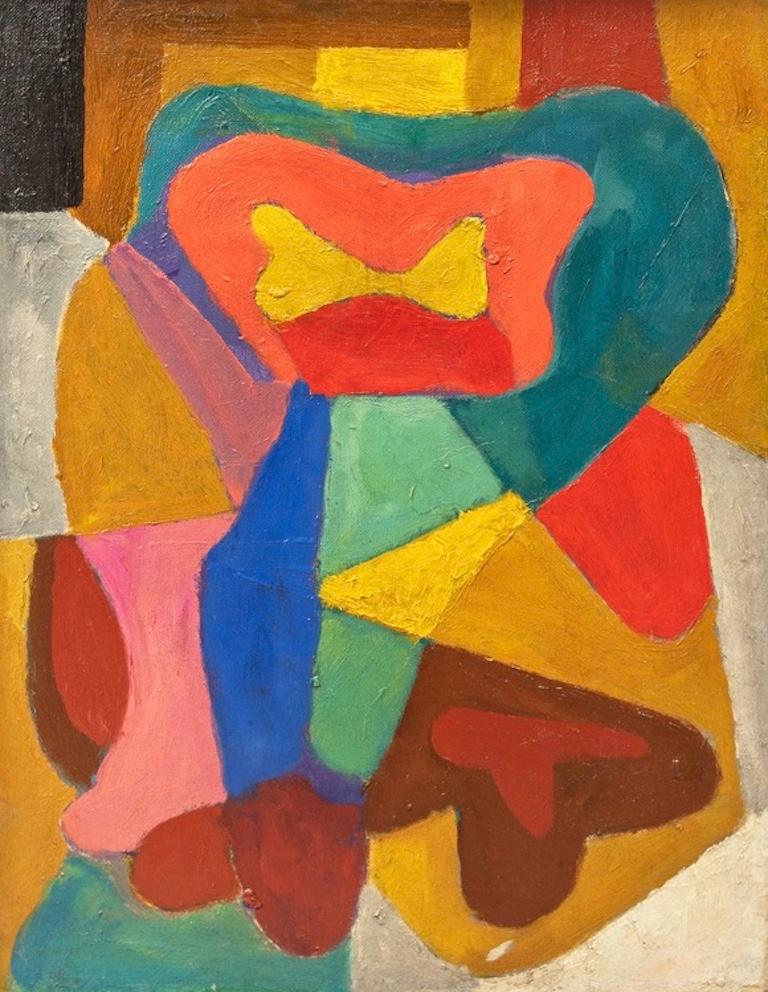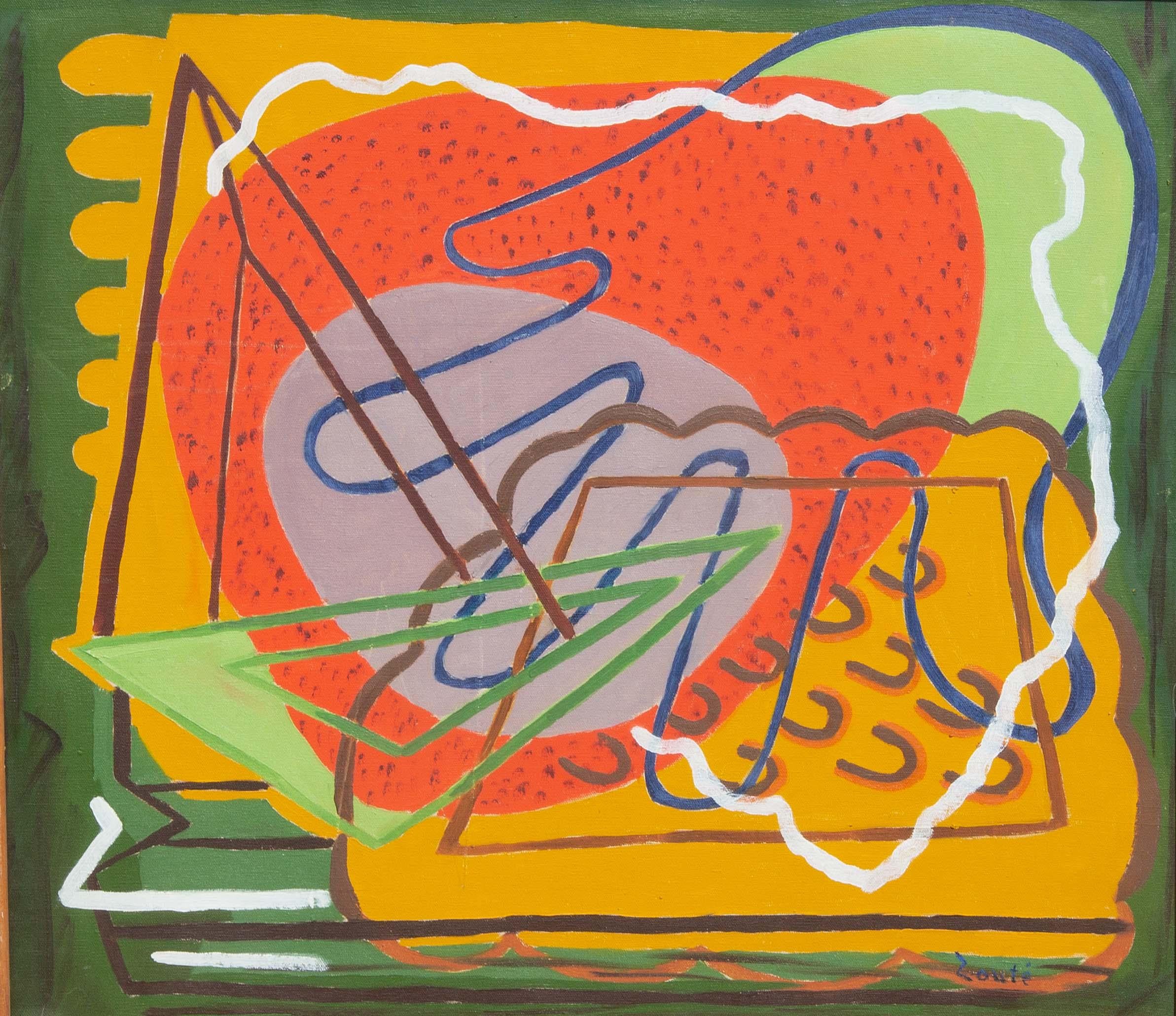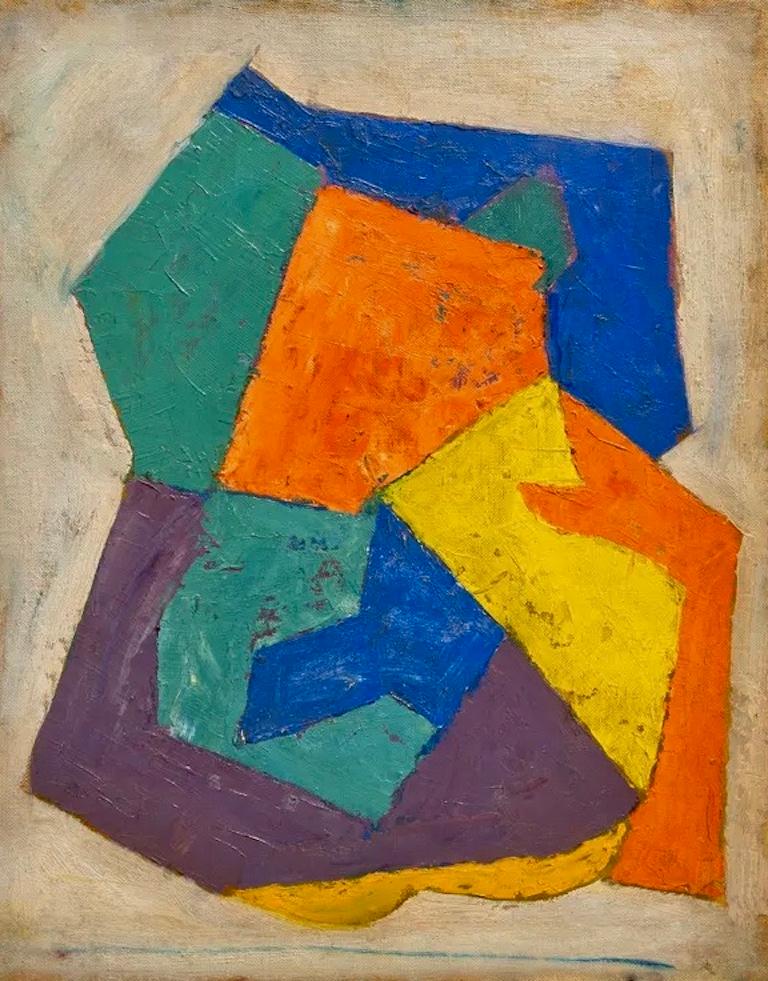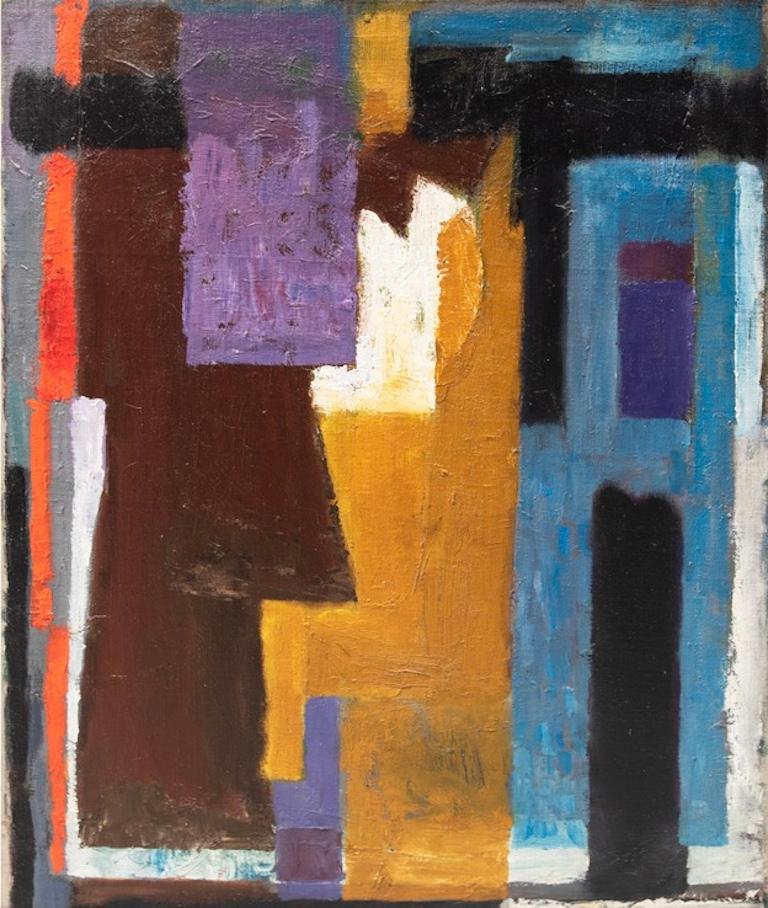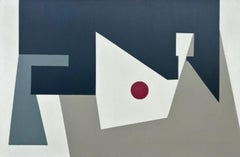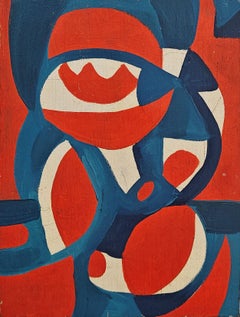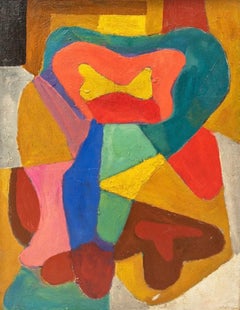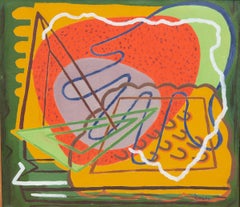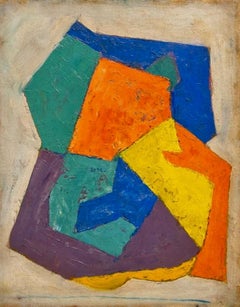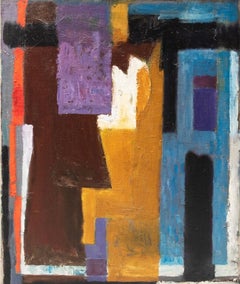Items Similar to "Abstract Interior of Room" Myron Lechay, Colorful Early Geometric Abstract
Want more images or videos?
Request additional images or videos from the seller
1 of 11
Myron Lechay"Abstract Interior of Room" Myron Lechay, Colorful Early Geometric Abstract1923
1923
$11,000
£8,390.04
€9,554.22
CA$15,458.36
A$16,859.51
CHF 8,931.03
MX$202,121.57
NOK 113,741.63
SEK 104,008.28
DKK 71,379.40
About the Item
Myron Lechay
Abstract Interior of Room, 1923
Signed upper right corner and dated upper left corner
Oil on canvas
24 x 20 inches
Provenance:
Estate of the artist
Spanierman Gallery, New York
Known for his delicate colorism and graceful abstract designs, Myron Lechay created landscapes and city views that have been compared to Stuart Davis's work of the 1920s and Milton Avery's art of the 1940s.
Lechay was born in Kiev, Russia. After emigrating to the United States with his family in 1906, he attended public schools. He received his initial art instruction at the National Academy of Design.
Lechay's first recognition occurred when the art and antiques dealer, F.W. Lawlor, observed him copying works by the Old Masters at the Metropolitan Museum of Art. Lawlor began to purchase works by Lechay on a regular basis, allowing the artist to support himself from his art.
By the 1920s, Lechay was participating in the New York avant-garde art scene. He became acquainted with leading American modernists such as Stuart Davis and became a member of the Société Anonyme, where he became familiar with the art of American modernists as well as progressive European artists including the Dadaists, Marcel Duchamp and Francis Picabia.
In the summer of 1921, Lechay joined Davis in the art colony of East Gloucester, Massachusetts. Lechay later wrote: "Stuart and I frequently met to talk of modern painting and poetry. Stuart explained what distinguished modern painting from all other kinds and I gathered impressions and opinions, new and invaluable." At Whitney Studio Club exhibitions, the works of Lechay and Davis were often hung side by side, no doubt because of their stylistic affinities.
In the 1920s, Lechay's career was launched when he was 'discovered' by Valentine Dudensing of the Valentine Gallery. Dudensing began to include the artist in his group shows, and gave him a retrospective exhibition in 1932, four one-man shows and a later retrospective in 1947. Critics applauded Lechay's economy of means and compared him to the French painters Henri Matisse, Piet Mondrian, and Raoul Dufy, whose work was also shown by Dudensing.
Lechay's summer sketching forays took him not only to Gloucester, but also to Marblehead and Nantucket, also in Massachusetts, and to Kennebunkport, Maine. Between 1921 and 1929, he worked in New Orleans, producing a group of works that received critical acclaim.
Lechay maintained a studio in New York City from the 1930s until his death in 1972. In addition to his showings at the Valentine Gallery and the Whitney Studio Club, he exhibited at the Carnegie Institute, the Brooklyn Museum, the Newark Museum and the Pennsylvania Academy of the Fine Arts. His work is represented in the Heckscher Museum, Huntington, New York; the Des Moines Art Center; Iowa; the Sheldon Memorial Art Gallery and Sculpture Garden, Lincoln, Nebraska; the Davenport Art Museum, Iowa and in many other public and private collections.
- Creator:Myron Lechay (1898-1972, American)
- Creation Year:1923
- Dimensions:Height: 25 in (63.5 cm)Width: 21 in (53.34 cm)
- Medium:
- Movement & Style:
- Period:
- Condition:
- Gallery Location:New York, NY
- Reference Number:1stDibs: LU1841213147432
About the Seller
5.0
Platinum Seller
Premium sellers with a 4.7+ rating and 24-hour response times
Established in 2022
1stDibs seller since 2022
132 sales on 1stDibs
Typical response time: <1 hour
- ShippingRetrieving quote...Shipping from: New York, NY
- Return Policy
More From This Seller
View All"Composition" Balcomb Greene, Geometric Abstract, Early Modernist Composition
By Balcomb Greene
Located in New York, NY
Balcomb Greene
Composition, 1936
Signed Balcomb Greene on verso upper stretcher bar
Signed on backing board: Balcomb Greene
Oil on canvas
30 1/4 x 46 inches
Provenance:
The artist
A...
Category
1930s Abstract Abstract Paintings
Materials
Canvas, Oil
"Ouverture, with Cypress Forms" Stephen Edlich, Abstract Geometric Painting
By Stephen Edlich
Located in New York, NY
Stephen Edlich
Ouverture, with Cypress Forms, 1982
Signed, dated and titled on the stretcher
Acrylic paint, mixed media, and burlap on canvas
60 x 40 inches
An artist who worked in the post-cubist and constructivist traditions, Stephen P. Edlich gained a considerable amount of acclaim in the 1970s and 1980s for his collages, sculpture, and paintings. His promising career was cut short due to his untimely death at age 45 in 1989.
Edlich was born in New York City. He received his undergraduate degree with a major in fine arts studies from New York University in 1967. During his college years, he traveled to London, where he met the art dealer Victor Waddington and created his first white on white collage. In that same year, he attended a major exhibition of the work of Ben Nicholson, which would be influential source in his art. Edlich returned to England in 1967, where he met Barbara Hepworth and Patrick Heron in London and traveled to St. Ives, Cornwall, long a favorite artists' haunt. Edlich began creating acrylic reliefs...
Category
1980s Abstract Geometric Abstract Paintings
Materials
Canvas, Burlap, Mixed Media, Acrylic
$60,000 Sale Price
20% Off
"Untitled" Albert Heckman, Mid-Century American Modernist Abstract Composition
By Albert Heckman
Located in New York, NY
Albert Heckman
Untitled
Signed lower left
Oil on canvas
20 x 24 inches
Albert Heckman was born in Meadville, Western Pennsylvania, 1893. He went to New York City to try his hand at...
Category
1950s Modern Abstract Paintings
Materials
Canvas, Oil
"Untitled" Howard Daum, Abstract, Red White and Blue, Modernist Composition
Located in New York, NY
Howard Daum
Untitled, 1972
Signed and dated on verso
Oil on board
10 1/8 x 8 inches
Howard Daum was born in Poland. His family lived in Lodz until he turned 14, when he and his mother left the counrtry. They settled in Montreal, Canada, where Daum learned from the artist Alexander Bercovitch from 1934 to 1937. In 1938, Daum and his mom traveled to New York and chose the Bronx as their home.
After finishing high school in 1940, Daum received a scholarship to the Art Students League. There, he learned from teachers like Will Barnet, Cameron Booth, Morris Kantor, Harry Sternberg, and Vaclav Vytlacil, who was a key mentor. Vytlacil had studied under modern painter Hans Hofmann in Munich in 1921 and helped start the American Abstract Artists group in 1936.
In 1943 and 1944, Daum served in the U. S. Army in Mississippi before coming back to New York. During 1944 and 1945, he had lessons with Hofmann at his school in Greenwich Village. Daum's art during this time became more abstract, using bold and bright colors with clear brushstrokes. The space in his work was very shallow, with objects like figures and easels overlapping each other.
Some of Daum’s artist friends, such as Robert Barrell, Peter Busa, and Steve Wheeler...
Category
1970s Abstract Abstract Paintings
Materials
Oil, Board
"Untitled" Albert Heckman, 1950s Modernist Abstracted Still Life Painting
By Albert Heckman
Located in New York, NY
Albert Heckman
Untitled, circa 1950
Signed lower right
Oil on canvas
21 1/4 x 29 inches
Albert Heckman was born in Meadville, Western Pennsylvania, 1893. He went to New York City to try his hand at the art world in 1915 after graduating from high school and landing a job at the Meadville Post Office. In 1917, at the age of 24, Heckman enrolled part-time in Teachers' College, Columbia University's Fine Arts Department to begin his formal art education. He worked as a freelance ceramic and textile designer and occasionally as a lecturer at the Metropolitan Museum of Art. In the early 1920s, at the age of almost 30, he graduated with a Bachelor of Arts degree from Columbia Teachers College. He was especially impacted by his instructor at Columbia, Arthur Wesley Dow.
After graduating, he was hired by the Teachers' College as a Fine Arts instructor. He stayed with Columbia Teachers' College until 1929, when he left to attend the Leipzig Institute of Graphic Arts in Leipzig, Germany. Isami Doi (1903-1965), who was born in Hawaii, was arguably his most impressive student at Columbia. Doi is now regarded as one of the most prominent artists hailing from Hawaii. Heckman became an active member and officer of the Keramic Society and Design Guild of New York in the 1920s as part of his early commercial art career. The Society's mission was to share knowledge and showcase textile and ceramic design exhibits.
In 1922, Heckman married Florence Hardman, a concert violinist. Mrs. Heckman's concert schedule during the 1920s kept Albert and Florence Heckman apart for a significant portion of the time, but they spent what little time they had together designing and building their Woodstock, New York, summer house and grounds. A small house and an acre of surrounding land on Overlook Mountain, just behind the village of Woodstock, were purchased by Albert and Florence Heckman at the time of their marriage. Their Woodstock home, with its connections, friendships, and memories, became a central part of their lives over the years, even though they had an apartment in New York City.
Heckman's main artistic focus shifted to the house on Overlook Mountain and the nearby towns and villages, Kingston, Eddyville, and Glasco. After returning from the Leipzig Institute of Graphic Arts in 1930, Mr. Heckman joined Hunter College as an assistant professor of art. He worked there for almost thirty years, retiring in 1956. Throughout his tenure at Hunter, Mr. Heckman and his spouse spent the summers at their Woodstock residence and the winters in New York City. They were regular and well-known guests at the opera and art galleries in New York. Following his retirement in 1956, the Heckmans settled in Woodstock permanently, with occasional trips to Florida or Europe during the fall and winter. Mr. Heckman's close friends and artistic career were always connected to Woodstock or New York City. He joined the Woodstock art group early on and was greatly influenced by artists like Paul and Caroline Rohland, Emil Ganso, Yasuo Kuniyoshi, Andre Ruellan, and her husband, Jack Taylor.
Heckman operated a summer art school in Woodstock for several years in the 1930s with support from Columbia University, where these and other Woodstock artists gave guest lectures. The Potter's Shop in New York City hosted Mr. Heckman's first art show in December 1928. The exhibit received some positive reviews from critics. The American Institute of Graphic Arts chose the plate of "Wehlen, Saxony" as one of the "Fifty Prints of the Year in 1929." There were sixteen etchings displayed. The remaining plates depicted scenes in Saxony, Germany, while five of the plates were based on scenes in Rondout, New York.
Heckman started switching from etching to black and white lithography by the early 1930s. A lifelong admirer of Heckman's artwork, Mr. Gustave von Groschwitz organized a significant exhibition of Heckman etchings and lithographs at the Ferargil Gallery in New York City in 1933. The exhibition traveled to the Stendahl Galleries in Los Angeles (May 1933), the Charles Lessler Gallery in Philadelphia (May 1933), J.L. Hudson in Detroit (June 1933), and Gumps in San Francisco (July 1933). Together with his early etchings, the exhibition featured brand-new black and white lithographs depicting scenes in and around Woodstock as well as "A View from Tudor City...
Category
1950s American Modern Figurative Paintings
Materials
Canvas, Oil
"Untitled" Albert Heckman, Still Life, Floral Abstracted Modernist Composition
By Albert Heckman
Located in New York, NY
Albert Heckman
Untitled, circa 1950
Signed lower right
Oil on canvas
25 1/4 x 32 1/4 inches
Albert Heckman was born in Meadville, Western Pennsylvania, 1893. He went to New York City to try his hand at the art world in 1915 after graduating from high school and landing a job at the Meadville Post Office. In 1917, at the age of 24, Heckman enrolled part-time in Teachers' College, Columbia University's Fine Arts Department to begin his formal art education. He worked as a freelance ceramic and textile designer and occasionally as a lecturer at the Metropolitan Museum of Art. In the early 1920s, at the age of almost 30, he graduated with a Bachelor of Arts degree from Columbia Teachers College. He was especially impacted by his instructor at Columbia, Arthur Wesley Dow.
After graduating, he was hired by the Teachers' College as a Fine Arts instructor. He stayed with Columbia Teachers' College until 1929, when he left to attend the Leipzig Institute of Graphic Arts in Leipzig, Germany. Isami Doi (1903-1965), who was born in Hawaii, was arguably his most impressive student at Columbia. Doi is now regarded as one of the most prominent artists hailing from Hawaii. Heckman became an active member and officer of the Keramic Society and Design Guild of New York in the 1920s as part of his early commercial art career. The Society's mission was to share knowledge and showcase textile and ceramic design exhibits.
In 1922, Heckman married Florence Hardman, a concert violinist. Mrs. Heckman's concert schedule during the 1920s kept Albert and Florence Heckman apart for a significant portion of the time, but they spent what little time they had together designing and building their Woodstock, New York, summer house and grounds. A small house and an acre of surrounding land on Overlook Mountain, just behind the village of Woodstock, were purchased by Albert and Florence Heckman at the time of their marriage. Their Woodstock home, with its connections, friendships, and memories, became a central part of their lives over the years, even though they had an apartment in New York City.
Heckman's main artistic focus shifted to the house on Overlook Mountain and the nearby towns and villages, Kingston, Eddyville, and Glasco. After returning from the Leipzig Institute of Graphic Arts in 1930, Mr. Heckman joined Hunter College as an assistant professor of art. He worked there for almost thirty years, retiring in 1956. Throughout his tenure at Hunter, Mr. Heckman and his spouse spent the summers at their Woodstock residence and the winters in New York City. They were regular and well-known guests at the opera and art galleries in New York. Following his retirement in 1956, the Heckmans settled in Woodstock permanently, with occasional trips to Florida or Europe during the fall and winter. Mr. Heckman's close friends and artistic career were always connected to Woodstock or New York City. He joined the Woodstock art group early on and was greatly influenced by artists like Paul and Caroline Rohland, Emil Ganso, Yasuo Kuniyoshi, Andre Ruellan, and her husband, Jack Taylor.
Heckman operated a summer art school in Woodstock for several years in the 1930s with support from Columbia University, where these and other Woodstock artists gave guest lectures. The Potter's Shop in New York City hosted Mr. Heckman's first art show in December 1928. The exhibit received some positive reviews from critics. The American Institute of Graphic Arts chose the plate of "Wehlen, Saxony" as one of the "Fifty Prints of the Year in 1929." There were sixteen etchings displayed. The remaining plates depicted scenes in Saxony, Germany, while five of the plates were based on scenes in Rondout, New York.
Heckman started switching from etching to black and white lithography by the early 1930s. A lifelong admirer of Heckman's artwork, Mr. Gustave von Groschwitz organized a significant exhibition of Heckman etchings and lithographs at the Ferargil Gallery in New York City in 1933. The exhibition traveled to the Stendahl Galleries in Los Angeles (May 1933), the Charles Lessler Gallery in Philadelphia (May 1933), J.L. Hudson in Detroit (June 1933), and Gumps in San Francisco (July 1933). Together with his early etchings, the exhibition featured brand-new black and white lithographs depicting scenes in and around Woodstock as well as "A View from Tudor City...
Category
1950s Abstract Figurative Paintings
Materials
Canvas, Oil
You May Also Like
"Abstraction" Mid 20th Century American Abstract 1960s Color Field
Located in New York, NY
"Abstraction" Mid 20th Century American Abstract 1960s Color Field
James Daugherty (1887 – 1974)
Abstraction
16 x 12 inches
Estate stamp verso
Oil on panel
Provenance: Estate of t...
Category
1960s Abstract Abstract Paintings
Materials
Oil, Panel
Abstract Composition by Zoute (Leon Salter) Mid Century
Located in Rochester, NY
Abstract Modernist oil painting by Zoute. Oil on canvas mounted on board. Painted in circa 1940's.
Zoute (Born-Leon Salter, 1903-1976) was self-taught and well exhibited during his l...
Category
Mid-20th Century Abstract Abstract Paintings
Materials
Canvas, Oil
"Abstraction" Mid-20th Century American Abstract 1960s Color Field Modernist
Located in New York, NY
"Abstraction" Mid-20th Century American Abstract 1960s Color Field Modernist
James Daugherty (1887 – 1974)
Abstraction with White Border
16 x 12 inches
Estate stamp verso
Oil on p...
Category
1960s Abstract Abstract Paintings
Materials
Oil, Panel
"Abstraction" Mid-20th Century American Abstract 1960s Color Field Modernist
Located in New York, NY
"Abstraction" Mid-20th Century American Abstract 1960s Color Field Modernist
James Daugherty (1887 – 1974)
"Abstraction"
58 ¼ x 41 ¾ inches
Signed and dated 1957 lower left
Oil on...
Category
1950s Abstract Abstract Paintings
Materials
Oil, Canvas
Colorful Abstract painting by Arnold Weber 1968
By Arnold Weber
Located in Long Island City, NY
Artist: Arnold Weber, American (1931 - 2010)
Title: Colorful Abstract
Year: 1968
Medium: Oil on Canvas, Signed, titled and dated l.l.
Size: 32 x 44 in. (81.28 x 111.76 cm)
Category
1960s Abstract Geometric Abstract Paintings
Materials
Oil
Antique American Modernist Abstract Expressionist Framed Colorful Oil Painting
Located in Buffalo, NY
Impressive early American modernist abstract oil painting. Framed. Oil on board. Image size, 36H by 28L.
Category
1960s Abstract Abstract Paintings
Materials
Canvas, Oil
More Ways To Browse
Francis Picabia
Oil Paintings Signed By Stuart
Antique Valentine
Gloucester Massachusetts
Nantucket Antique
Antique Avery
Paintings Of Room Interiors
Blue Jay Painting
Camellia Painting
Gillian Ayres
Large Vertical Paintings
Rhode Island Painting
Saito Kikuo
Solo Sofa
Cubism Oil Painting
Karl Otto
Katia Pissarro
Painting Secret Garden

